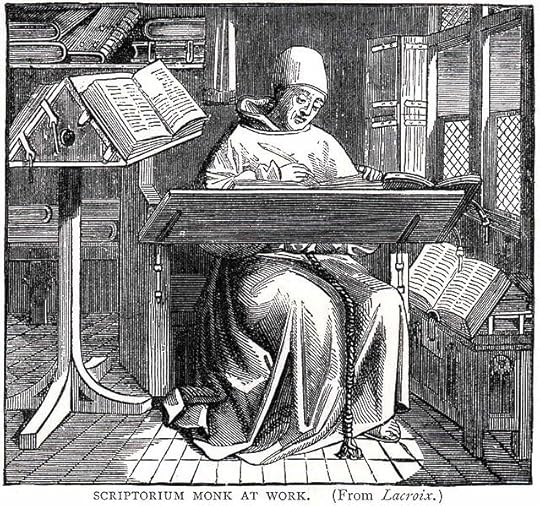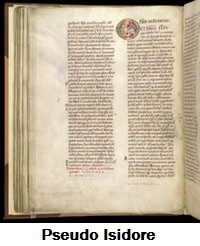The Pope--A Medieval Invention
 With Pope Francis’ speedy election by the College of Cardinals, Catholics are holding their collective breath to see which way the newest pontiff steers the church. Papal Conclaves are an old tradition, but not as old, or as traditional, as you might think. In fact, the papacy--with the pope as titular head of all Catholics—only dates to early medieval times, to the mid-ninth century. And the Vatican’s authority comes, not from earliest Catholic tradition, but from a collection medieval documents penned in the Picardy region of northern France.
With Pope Francis’ speedy election by the College of Cardinals, Catholics are holding their collective breath to see which way the newest pontiff steers the church. Papal Conclaves are an old tradition, but not as old, or as traditional, as you might think. In fact, the papacy--with the pope as titular head of all Catholics—only dates to early medieval times, to the mid-ninth century. And the Vatican’s authority comes, not from earliest Catholic tradition, but from a collection medieval documents penned in the Picardy region of northern France. Nestled in the Somme river valley, at the confluence of the Ancre river, lies the town of Corbie. The historic town surrounds Corbie Abbey, founded in the seventh century by Saint Balthild, Queen of the Franks. But it wasn’t always an abbey. In the ninth century, Corbie was one of the most powerful monasteries in the Holy Roman Empire—more powerful even than Saint Denis in Paris.
 So what was so important about the goings on in ninth-century Corbie Monastery that made it so powerful? Those industrious monks were hard at work in the scriptorium manipulating the world, but more on that later. First, a bit about the monastery. It was founded around 660 A.D. and by the ninth century, Corbie had become one of the largest monasteries in France. As it grew in size, so, too, did its influence. Corbie Abbots were granted the same rank as counts, and were exempted from the authority of the bishop of the diocese. The monastery was even given the right to mint its own currency!
So what was so important about the goings on in ninth-century Corbie Monastery that made it so powerful? Those industrious monks were hard at work in the scriptorium manipulating the world, but more on that later. First, a bit about the monastery. It was founded around 660 A.D. and by the ninth century, Corbie had become one of the largest monasteries in France. As it grew in size, so, too, did its influence. Corbie Abbots were granted the same rank as counts, and were exempted from the authority of the bishop of the diocese. The monastery was even given the right to mint its own currency!But Corbie’s real importance was its extensive library, scriptorium and, most importantly, its scholars. Under the watchful eyes of theological geniuses, like Hadoard and Ratramnum, scribes produced mountains of philosophical, historical and theological treatises. But that’s not all they manufactured. Abbot Paschasius Radbertus and the scribes in his charge created the world’s greatest forgery: the Decretals of Isidore Mercator, a fake that changed western Christianity forever. In fact, it wasn’t until Mussolini that a portion of Corbie’s blatant power grab was made right.
 As experts in monastic script studied the anthology of letters that comprised the Decretals of Isidore Mercator, it became obvious by the handwriting that they were forged. And while medieval theologians universally agreed that the Decretal’s one hundred letters--supposedly authored by popes and bishops during the first three centuries after Christ--gave the papacy absolute power, it was just as certain that none of the letters were written then. Each and every one had been penned in the last few years, and all of them at Corbie monastery. Curiously, many of the passages resembled the writing style of the brilliant author and theologian, Abbot Paschasius Radbertus.
As experts in monastic script studied the anthology of letters that comprised the Decretals of Isidore Mercator, it became obvious by the handwriting that they were forged. And while medieval theologians universally agreed that the Decretal’s one hundred letters--supposedly authored by popes and bishops during the first three centuries after Christ--gave the papacy absolute power, it was just as certain that none of the letters were written then. Each and every one had been penned in the last few years, and all of them at Corbie monastery. Curiously, many of the passages resembled the writing style of the brilliant author and theologian, Abbot Paschasius Radbertus. Tucked away in the collection of blatant forgeries was perhaps the most brazen of the church’s fakes: the Donation of Constantine. The Donation conveyed colossal power to the papacy proclaiming, among other things, that the Bishop of Rome was Christ’s representative on earth, and giving him dominion over all the churches of God in the whole world!
Pope Leo IV relied on the Donation to command that the title Pope would be reserved exclusively for the Bishop of Rome. Bishops the world over were confused, since they were already called pope--which simply meant father--by their congregations. Even priests were affectionately called pope. The Patriarchs of Alexandria and Africa and the Patriarchs of Antioch and Constantinople, also popes, protested the effrontery.

So what does it all mean? Before the ninth century, there was no pope, at least not as we know the papacy today. The Pope was nothing more than the Bishop of Rome, and had no authority outside the Roman diocese. Nor did the Bishop of Rome have any authority over any other bishop or even priest outside his bishopric. That all changed with the Isidore fake. And based on the Donation of Constantine forgery, the church seized land that became the Papal States. Mussolini took back most of the land in 1929, but the church still retains land that it claimed based on the forgery—land that today is its own country: The Vatican.
Published on March 03, 2013 09:57
•
Tags:
papal-conclave, pope, prophecy-of-the-popes, saint-malachy
No comments have been added yet.



